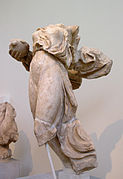Nike (goddess of victory)
Nike ( ancient Greek Νίκη Níkē or Νίκα Níka "victory") is the goddess of victory in Greek mythology . Its Roman equivalent is Victoria . The center of their cult in Athens was the Acropolis .
ancestry
With Hesiod and in the library of Apollodorus , Nike is the daughter of Styx and Pallas , her siblings are Bia , Zelos and Kratos . Together they helped Zeus in the fight against the titans . In an Orphic hymn , Ares is mentioned as her father. Hyginus also mentions Styx and Pallas as parents of Victoria, her siblings are Scylla, Vis, Invidia, Potestas, Fontes and Lacus.
Representations
In the first decades of the 5th century BC, vase paintings, relief sculptures, toreutics and architectural elements such as akrotere can be found. Different Nikes representations. During the 5th century BC In BC, Nike became an official monument to victory.
In art, with one exception, it is always depicted as winged. Often they were depicted on memorials erected to commemorate great victories, where Zeus or Athena carry their image on their hands to show that those gods had granted the worshipers of these statues the victory.
In the red-figure vase painting she appears in various functions, for example as a donor to the victim with a tripod , but also in sepulcral contexts , as a companion in agonal competitions, as an attribute of a victorious deity or, as on a bronze sheet from the early 5th century BC. Depicted as a charioteer of a four-horse carriage. Often the Nike is also depicted as an acroter of various shrines. An acroternike from the Asclepius sanctuary in Epidaurus carries a partridge in her hand as an explanatory attribute.
The iconography does not reveal a clear scope of duties for Nike. With the end of the archaic era, the almost stereotypical representation of Nike in the knee-run scheme also changes , so that in addition to other emerging motifs of movement, the area of action of Nike also grows. The representation in connection with a military victory is only a minor aspect of the vase painting.
In the round sculpture, however, this point is the only aspect that is considered. This results from the listing of the Nikes as anathemes . Here she appears as a single figure without attributes.
You see Nike with different objects: Sometimes with a kithara ( lyre ) and a phiale , with a thymiaterion (incense burner) and a flower, with a sash or with a jug ( oinochoe ) at the libation at the altar.
photos
- Nikes statues
Nike from Delos , 6th century BC. Chr.
German Nike on the Berlin Olympic site
Nike '89 at Glienicke Bridge , Potsdam
See also
literature
- Alexandra Gulaki: Classical and Classicist Nikedabbilder. Studies on typology and the change in meaning. (Diss. Univ., Bonn 1981)
- Cornelia Isler-Kerényi : Nike. The type of the running wing woman in archaic times. Rentsch, Erlenbach-Zürich et al. 1969. pp. 95ff. (Diss., Zurich).
- Walter Pötscher : Nike 1). In: The Little Pauly (KlP). Volume 4, Stuttgart 1972, column 100 f.
- Cornelia Thöne: Iconographic studies on Nike in the 5th century BC Investigations into the mode of action and nature (= archeology and history 8). Verlag Archäologie und Geschichte, Heidelberg 1999, ISBN 3-9804648-2-2 (also: Heidelberg, Univ., Diss., 1992).
Web links
Individual evidence
- ↑ Hesiod : Theogony 383.
- ^ Libraries of Apollodorus 1, 9.
- ↑ Orphic Hymn 88, 4.
- ^ Hyginus : Fabulae introduction
- ↑ Thöne 1999, p. 28 f.
- ↑ Att. Rf. Bell crater, around 420 BC Chr .; LIMC VI (1992) 585 Fig. 335 sv Nike (A. Goulaki-Voutira)
- ↑ Att. Wgr. Lekythos, around 420/400 BC Chr .; LIMC VI (1992) 587 Fig. 366 sv Nike (A. Goulaki-Voutira)
- ↑ Att. Rf. Skyphos, around 440 BC Chr .; LIMC VI (1992) 583 Fig. 318 sv Nike (A. Goulaki-Voutira)
- ↑ LIMC VI (1992) 573 Fig. 144 sv Nike (A. Goulaki-Voutira)
- ↑ Thöne 1999, p. 27.






